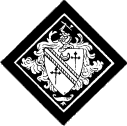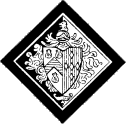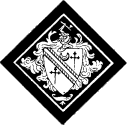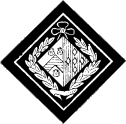Achievements
Achievements
Achievements, spelt sometimes atchievements, and more frequently hatchments: coats of arms in general, and particularly those funeral escutcheons, which being placed upon the fronts of houses or in churches, or elsewhere, set forth the rank and circumstances of the deceased. The arms upon the latter may in all cases be either single or quartered.
When the deceased is the last of his line a death's head may be placed over his arms instead of, or besides, the crest.
A. OFFICIAL PERSONAGES. 1, 2. A king or reigning queen, whether married or not.--The royal arms complete, upon a ground entirely black.
3. A queen consort.--The achievements of a queen consort should be arranged in a manner similar to that of the lady of a peer.
4. Archbishops and bishops.--An archbishop or bishop has his paternal arms impaled after the insignia of his see, both being surmounted by a mitre. The ground must be per pale, white on the dexter side, signifying that the see never dies, and black on the sinister, denoting the decease of the bishop. Whether the bishop be married or unmarried will make no difference in the arrangement of his achievement.
The arms of the bishops of Winchester and Oxford(the one, prelate, and the other, chancellor of the order of the garter) should be encircled by the garter, and have their badges pendent. The archbishops of Armagh and Dublin bear the badge of the order of S.Patrick in the same manner. Prelates having temporal jurisdiction, (as the bishops of Durham had,) may bear a crosier and sword saltirewise behind their arms; the hilt of the sword should be uppermost.
5, 6. The dean of a cathedral or collegiate church, or the head of a college, whether married or not.--The insignia of the deanery or college impaled with the paternal coat must be placed upon a ground parted per pale white and black, as in No. 4. A dean or other clerk should by no means bear a helmet, mantle, or crest.
The deans of Windsor, Westminster, and S.Patrick's, Dublin, should bear the badges of their respective orders.
7. Kings of Arms.--The achievement of a king of arms should contain the insignia of his office and his paternal coat impaled together, and surmounted by his helmet, crest, mantling, and crown. Some kings of arms have encircled their shields with the collar of SS belonging to their office. The ground of this achievement must be, like the above, per pale white and black.

B. BACHELORS. All bachelors(official personages already mentioned being excepted), must have their arms complete, that is to say, with all the external ornaments belonging to their condition, upon a black ground, namely, if an esquire, with his wreath, helmet, and crest, and perhaps it may be with a mark of cadency on the arms. The arms being without any impalement, or any escutcheon of pretence, shews that the bearer was an unmarried man.


C. HUSBANDS. 1. In general.--All husbands(except those whose wives are peeresses in their own right) should have a shield with the external ornaments proper to their rank, containing their own arms on the dexter side, impaled with their wives' on the sinister side, or if the latter be heiresses theirs must be upon an escutcheon of pretence. In all cases the ground will be per pale black and white, the dexter being black to denote the husband's decease.
According to some modern heralds it is not proper for a knight to include the arms of his wife within the collar, ribbon, or other insignia of his order. In compliance with this opinion it is customary for the achievement of a knight(whether a peer or not) to be arranged thus:--Two shields are placed side by side, the first, which is encircled by the garter or other distinction of the order, contains the husband's arms alone, and the second those of the husband and wife. Both these shields are included within the external ornaments pertaining to the husband's rank. The ground is perpendicularly divided at the middle of the second shield, the dexter side black, the sinister white.
Marriages previous to the last one should not be noticed upon achievements.
2. A husband of any rank, whose lady is a peeress in her own right.--Two escutcheons; the dexter containing the arms of the husband with the lady's upon an escutcheon of pretence ensigned with her coronet: the sinister lozenge-shaped, with the lady's alone. Each must be accompanied by all its proper external ornaments. The ground should be perpendicularly divided at the middle of the dexter escutcheon, and painted black and white.
D. WIDOWERS. Their funeral achievements only differ from those of husbands, under similar circumstances, in the ground being totally black.
Woman(sovereign princesses excepted) may not bear helmets, crests, or mantlings, but a peeress is entitled to her robe of estate.
E. UNMARRIED LADIES OF ANY RANK. The arms of an unmarried lady must be placed in a lozenge, but no external ornaments of an heraldic nature should be used, unless she were a peeress. In that case her supporters, robe of estate and coronet, should be added: the ground entirely black. Shells, cherubims' heads, and knots or bows of ribbon, are often placed above the arms of women, whether spinsters, wives, or widows.
F. WIVES. 1. In general.--Their achievements are arranged precisely as their husbands' would be, except that the helmet, crest, mantle, and motto, are omitted, and the ground painted per pale, white and black, or, to speak more accurately, black under the arms of the wife, and white under those of the husband.
2. The wife of an archbishop or bishop.--It is customary to arrange the achievement of the wife of a prelate thus:--Two shields, the first containing the impaled arms of the see and the bishop, surmounted by a mitre, and the second, the family arms of the bishop with those of his wife, and over them a knot of ribbons or a cherub's head: the ground all white except that part under the arms of the wife(i.e. about one third per pale on the sinister side), which must be black.

G. WIDOWS. The achievements of widows differ from those of wives in two respects; the escutcheon or escutcheons are lozenge-shaped(escutcheons of pretence excepted), and the ground is entirely black. The arms should be encircled by a silver Cordon, which is the special symbol of widowhood.
As the episcopal dignity in one in which a wife cannot participate, the achievement of a prelate's widow should not differ from that of the widow of a private gentleman. The same may be said of the widow of a knight.
The place for affixing the arms above described is against the residence of the deceased; but some years ago in many churches, but now in very few, helmets and banners of some deceased knight were frequently found remaining hung up in some aisle or chapel, and these also went by the name of hatchments. The banners in St.George's, Windsor, afford the most complete example of the survival of an old custom, and here also the achievement is engraved on a plate in the stall held by each successive knight of the Order of the Garter.
In France the litre, or lisiere, hung around the churches, answers, perhaps, to the hatchment.
Please Help!
DrawShield is a Free service supported by its users.

If you can, please help cover the cost of the server, or just buy the team a coffee to say thanks!
 Buy me a coffee
Buy me a coffee


